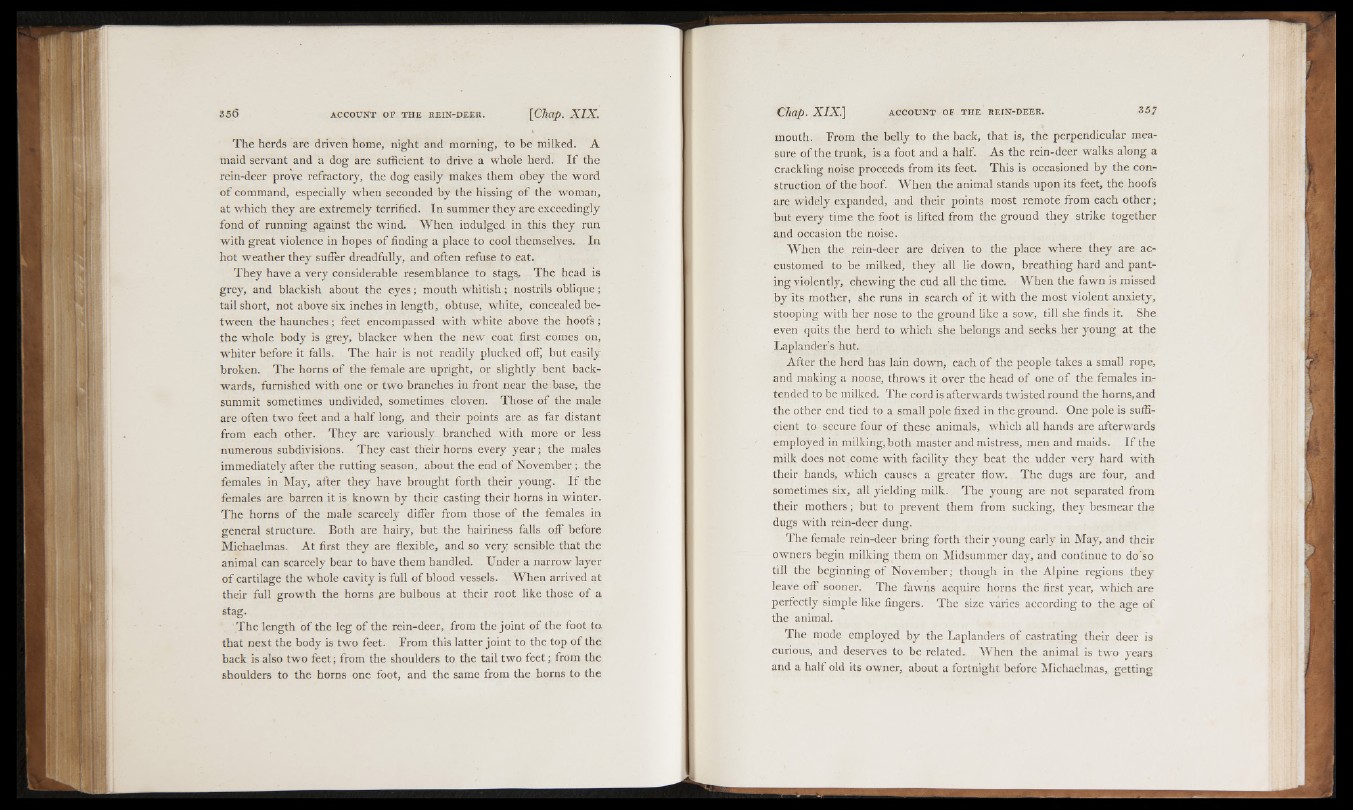
The herds are driven home, night and morning, to be milked. A
maid servant and a dog are sufficient to drive a whole herd. I f the
rein-deer prove refractory, the dog easily makes them obey the word
o f command, especially when seconded by the hissing of the woman,
at which they are extremely terrified. In summer they are exceedingly
fond of running against the wind. When indulged in this they run
with great violence in hopes of finding a place to cool themselves. In
hot weather they suffer dreadfully, and often refuse to eat.
They have a very considerable resemblance to stags. The head is
grey, and blackish about the eyes; mouth whitish; nostrils oblique;
tail short, not above six inches iri length, obtuse, white, concealed between
the haunches; feet encompassed with white above the hoofs;
the whole body is grey, blacker when the new coat first comes on,
whiter before it falls. The hair is not readily plucked off, but easily
broken. The horns o f the female are upright, or slightly bent backwards,
furnished with one or two branches in front near the base, the
summit sometimes undivided, sometimes cloven. Those o f the male
are often two feet and a half long, and their points are as far distant
from each other. They are variously branched with more or less
numerous subdivisions. They cast their horns every year; the males
immediately after the rutting season, about the end of November; the
females in May, after they have brought forth their young. I f the
females are barren it is known by their casting their horns in winter.
The horns o f the male scarcely differ from those of the females in
general structure. Both are hairy, but the hairiness falls off before
Michaelmas. At first they are flexible, and so very sensible that the
animal can scarcely bear to have them handled. Under a narrow layer
of cartilage the whole cavity is full of blood vessels. When arrived at
their full growth the horns are bulbous at their root like those of a
stag.
The length of the leg of the rein-deer, from the joint of the foot to
that next the body is two feet. From this latter joint to the top of the
back is also two feet; from the shoulders to the tail two feet; from the
shoulders to the horns one foot, and the same from the horns to the
mouth. From the belly to the back, that is, the perpendicular measure
of the trunk, is a foot and a half. As the rein-deer walks along a
crackling noise proceeds from its feet This is occasioned by the construction
of the hoof. When the animal stands upon its feet, the hoofs
are widely expanded, and their points most remote from each other;
but every time the foot is lifted from the ground they strike together
and occasion the noise.
When the rein-deer are driven to the place where they are accustomed
to be milked, they all lie down, breathing hard and panting
violently, chewing the cud all the time. When the fawn is missed
by its mother, she runs in search of it with the most violent anxiety,
stooping with her nose to the ground like a sow, till she finds it. She
even quits the herd to which she belongs and seeks her young at the
Laplander’s hut.
After the herd has lain down, each of the people takes a small rope,
and making a noose, throws it over the head o f one o f the females intended
to be milked. The cord is afterwards twisted round the horns, and
the other end tied to a small pole fixed in the ground. One pole is sufficient
to secure four of these animals, which all hands are afterwards
employed in milking, both master and mistress, men and maids. I f the
milk does not come with facility they beat the udder very hard with
their hands, which causes a greater flow. The dugs are four, and
sometimes six, all yielding milk. The young are not separated from
their mothers; but to prevent them from sucking, they besmear the
dugs with rein-deer dung.
The female rein-deer bring forth their young early in May, and their
owners begin milking them on Midsummer day, and continue to do so
till the beginning of November; though in the Alpine regions they
leave off sooner. The fawns acquire horns the first year, which are
perfectly simple like fingers. The size varies according to the age of
the animal.
The mode employed by the Laplanders o f castrating their deer is
curious, and deserves to be related. When the animal is two years
and a half old its owner, about a fortnight before Michaelmas, getting